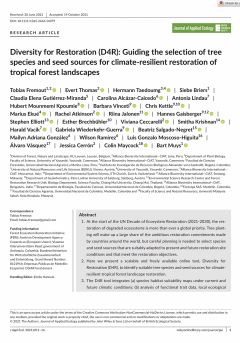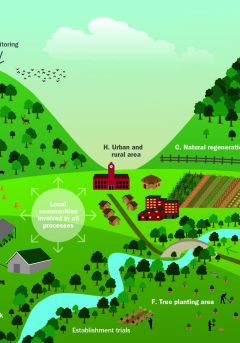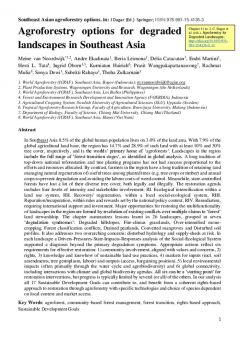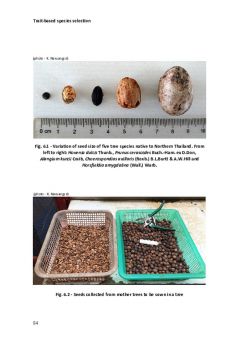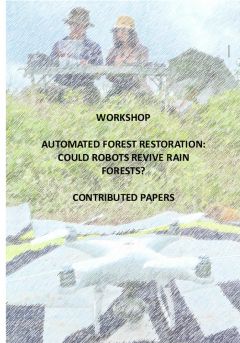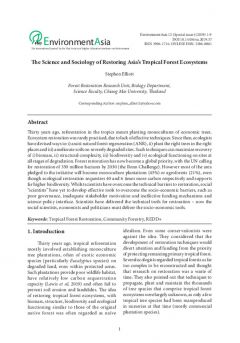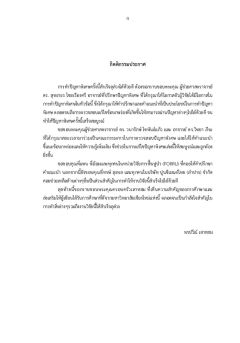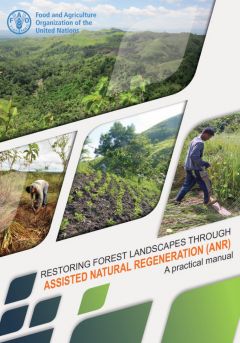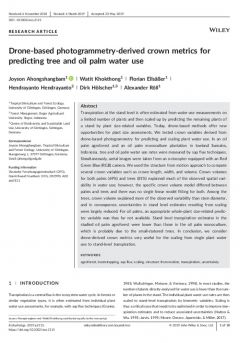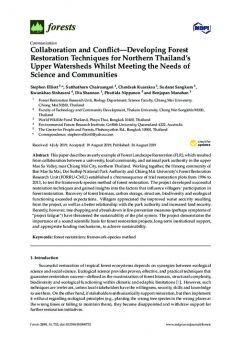Extensive study has been made by FORRU, local forestry staff and students of Wailailak University of the trees of the lowland forest in the remaining range of Gurney’s Pitta in southern Thailand, including the identity of species and their flowering and fruiting phenologies. Over 180 species of tree have been identified and reference and voucher collections made of leaves and seeds. Phenology trails have been established and over 200 trees individually labelled.
Detailed measurements of sapling growth rates have been made in the tree nursery to identify potential framework species for forest restoration, and field visits have established the identity of trees capable of regenerating in deforested areas. Three different forest restoration methods have been trialled and closely monitored at experimental plots; accelerated natural regeneration, replanting with framework species and direct seeding. All three show potential for wider forest restoration. A technical guide to forest restoration methods in the area has been produced.
Moreover, a local school curriculum “Gurney’s Pitta and Nature” was developed mainly by BCST and its partners. The curriculum aims to i) establish systematically basic learning about Gurney’s Pitta, ii) promote this subject at higher levels of education, iii) promote Gurney’s Pitta as a flagship species for conservation and iv) raise awareness of local people on Gurney’s Pitta conservation.
11: Diversity for Restoration (D4R): Guiding the selection of tree species and seed sources for climate-resilient restoration of tropical forest landscapes
ABSTRACT: 1. At the start of the UN Decade of Ecosystem Restoration (2021–2030), the restoration of degraded ecosystems is more than ever a global priority. Tree planting will make up a large...
12: Ten guidelines for tree planting initiatives to optimise carbon sequestration, biodiversity recovery and livelihood benefits
ABSTRACT: Urgent solutions to global climate change are needed. Ambitious tree‐planting initiatives, many already underway, aim to sequester enormous quantities of carbon to partly compensate for...
13: Agroforestry options for degraded landscapes in Southeast Asia
ABSTRACT: In Southeast Asia 8.5% of the global human population lives on 3.0% of the land area. With 7.9% of the global agricultural land base, the region has 14.7% and 28.9% of such land with at...
14: A trait-based approach for selecting tree species for aerial seeding
ABSTRACT: We review recent ecological research on functional traits that can aid selection of tree species for restoration by aerial seeding. A major barrier in selecting species for restoration...
15: Forest restoration: concepts and the potential for its automation
ABSTRACT: In 2014, the UN New York Climate Summit set a goal to restore forest to 350 million hectares of degraded land by 2030, to counter climate change. Conventional tree-planting with human...
16: The science and sociology of restoring Asia’s tropical forest ecosystems
ABSTRACT: Thirty years ago, reforestation in the tropics meant planting monocultures of economic trees. Ecosystem restoration was rarely practised, due to lack of effective techniques. Since then,...
17: Diversity of Ground Flora in Restoration Area of The Siam Cement (Lampang) Co., Ltd Limestone Quarry
Ground flora communities in framework species method restoration area of Siam cement (Lampang) Co. Ltd. limestone quarries were studied. adding top soil with the value of 2.81, 2.50 and 1.99,...
18: Restoring forest landscapes through assisted natural regeneration (ANR) – A practical manual
The first rule of forest restoration is to make maximum use of what's already on-site. Every naturally establishing tree is one less tree to plant—and tree planting is expensive. So, exploiting...
19: Drone‐based photogrammetry‐derived crown metrics for predicting tree and oil palm water use
ABSTRACT: Transpiration at the stand level is often estimated from water use measurements on a limited number of plants and then scaled up by predicting the remaining plants of a stand by plant...
20: Collaboration and conflict - developing forest restoration techniques for northern Thailand’s upper watersheds whilst meeting the needs of science and communities
ABSTRACT: This paper describes an early example of Forest Landscape Restoration (FLR), which resulted from collaboration between a university, local community, and national park authority in the...

